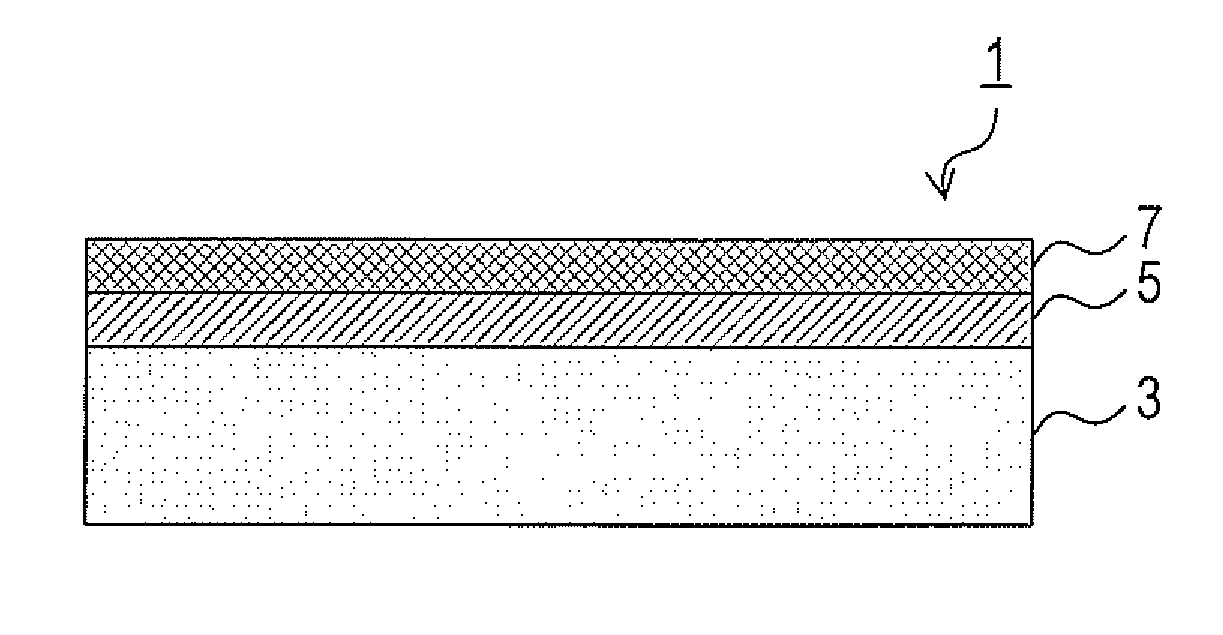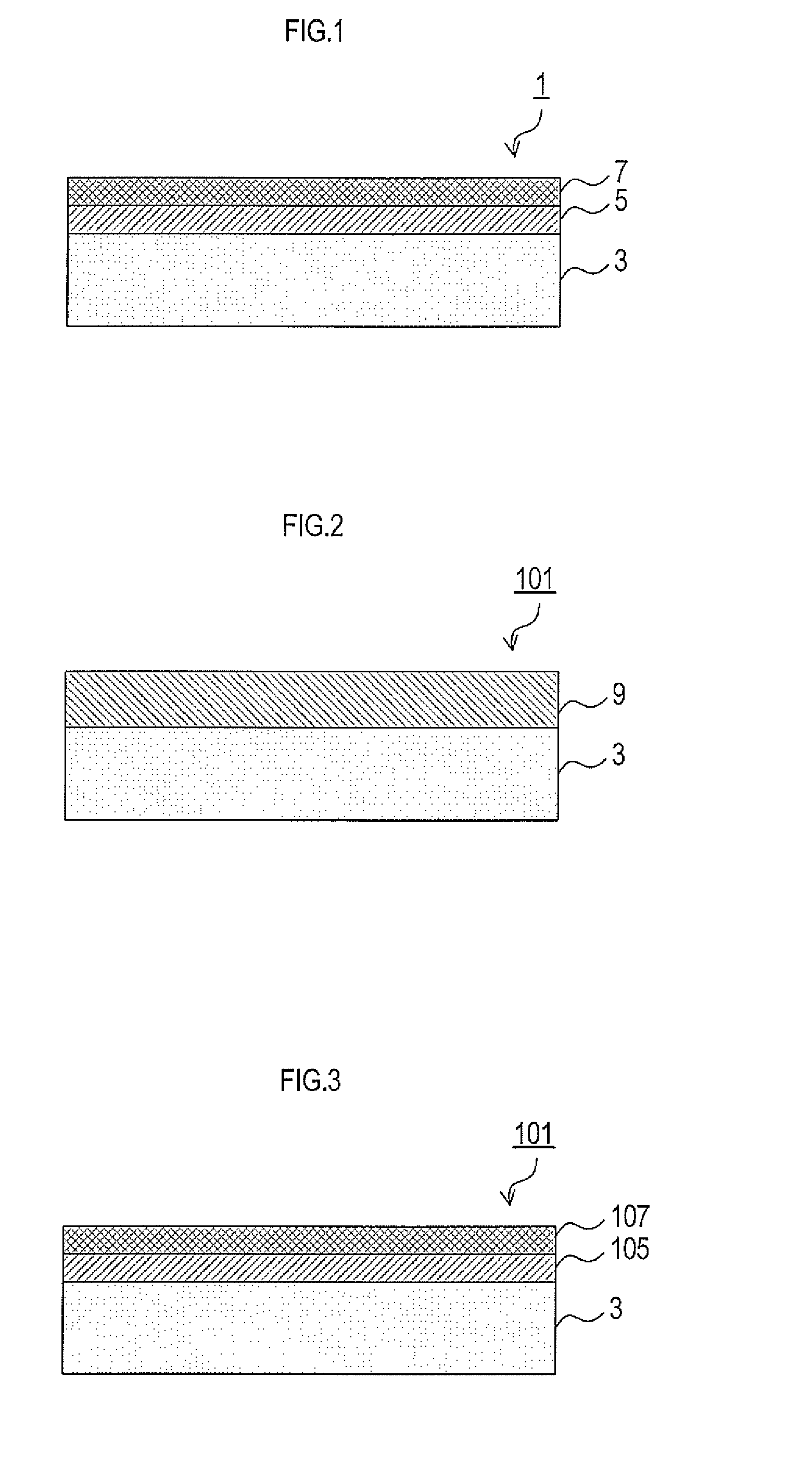Exhaust gas purifying catalyst
a technology of exhaust gas and purifying catalyst, which is applied in the direction of physical/chemical process catalysts, other chemical processes, separation processes, etc., can solve the problems of carbon dioxide emitted from the internal combustion engine of the automobile and other problems, and achieve the effect of preventing the loss of zirconia properties, and improving the inhibition
- Summary
- Abstract
- Description
- Claims
- Application Information
AI Technical Summary
Benefits of technology
Problems solved by technology
Method used
Image
Examples
embodiment 1
[0033]a) A description will now be given on a structure of an exhaust gas purifying catalyst 1 of an Embodiment 1 with reference to FIG. 1.
[0034]The exhaust gas purifying catalyst 1 includes an inside layer 5 formed on the surface of a substrate (catalyst substrate) 3, and an outside layer 7 further formed on top of the inside layer 5. The inside layer 5 and the outside layer 7 function as a catalyst coating layer. The substrate 3 is a monolith honeycomb substrate having a capacity of 1.0 L and a cell density of 400 cells / in2. The inside layer 5 and the outside layer 7 are formed on the inner face of each cell of the substrate 3.
[0035]The inside layer 5 has the following composition.
[0036]Rh: 0.5 g / L
[0037]Zr-based composite oxide added with 2 weight % of Ca in terms of oxide: 50 g / L
[0038]Ba
[0039]Li
[0040]K
[0041]The outside layer 7 has the following composition.
[0042]Pt: 2 g / L
[0043]alumina: 100 g / L
[0044]ZnTi composite oxide: 100 g / L
[0045]CeZr composite oxide: 20 g / L
[0046]Ba
[0047]Li
[00...
embodiment 2
[0061]The exhaust gas purifying catalyst 1 of an Embodiment 2 has basically the same structure as that of the Embodiment 1, but partly differs in the inside layer 5. Explanation below will focus on the difference. The inside layer 5 in the present embodiment contains an oxide including only zirconia (hereinafter, referred to as “zirconia”) instead of the Zr-based composite oxide added with 2 weight % of Ca in terms of oxide.
[0062]The method of manufacturing the exhaust gas purifying catalyst 1 of the Embodiment 2 is basically the same as that of the Embodiment 1. In the Embodiment 2, a slurry S3 was used in place of the slurry S1 to form the inside layer 5. The slurry S3 was prepared by mixing below listed components.
(Slurry S3)
[0063]Rh nitrate solution: an amount containing 0.5 g of Rh
[0064]zirconia: 50 g
[0065]water: 100 g
embodiment 3
[0066]The exhaust gas purifying catalyst 1 of an Embodiment 3 has basically the same structure as that of the Embodiment 1, but differs in that the outside layer 7 contains not only Pt but Pt (1.5 g / L) and Pd (0.5 g / L) as the noble metal.
[0067]The method of manufacturing the exhaust gas purifying catalyst 1 of the Embodiment 3 is basically the same as that of the Embodiment 1. In the Embodiment 3, the substrate 3 was dipped not in a Pt nitrate solution but in a PtPd nitrate solution (an amount containing 1.5 g of Pt and 0.5 g of Pd) after the outside layer 7 was formed so as to make the outside layer 7 support 1.5 g / L of Pt and 0.5 g / L of Pd. The step of making the substrate 3 support Ba, K and Li thereafter is the same as that of the Embodiment 1.
PUM
| Property | Measurement | Unit |
|---|---|---|
| operating temperature | aaaaa | aaaaa |
| weight percent | aaaaa | aaaaa |
| temperatures | aaaaa | aaaaa |
Abstract
Description
Claims
Application Information
 Login to View More
Login to View More - R&D
- Intellectual Property
- Life Sciences
- Materials
- Tech Scout
- Unparalleled Data Quality
- Higher Quality Content
- 60% Fewer Hallucinations
Browse by: Latest US Patents, China's latest patents, Technical Efficacy Thesaurus, Application Domain, Technology Topic, Popular Technical Reports.
© 2025 PatSnap. All rights reserved.Legal|Privacy policy|Modern Slavery Act Transparency Statement|Sitemap|About US| Contact US: help@patsnap.com


